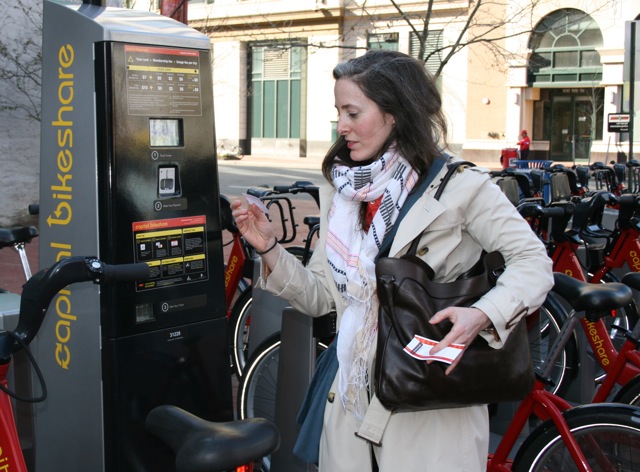About 300 kiosks have been set up; the number is expected to double over the next few years. Perhaps in response to complaints about them, the kiosks are movable. In Paris and London, where two of the earliest bike-share programs began, the kiosks were trenched into the ground, making them difficult to maneuver or remove. The Big Apple instead took its construction cues from Montreal, where the kiosks are anchored by nothing more than their own weight. Thus, spaces can be moved or removed for construction or emergencies.
 |
| Commuter at Capital Bikeshare kiosk in Washington, DC. From Velojoy |
Some people questioned the wisdom of adding so many more bikes to the city's streets. I, for one, think questions should have been directed at the idea of trying to shoehorn as many motorized vehicles as possible into the city's streets--which seemed to be the Department of Transportation's guiding policy for decades. It's not the number of bikes on the street that increases the risk of injury or death, as some allege.
Such critics point to the three cyclists who were killed during Velib's first year of operation in the City of Light. Rather than to blame a bike-share program--for, essentially, getting people to abandon their pre-Velib modes of transportation--more attention needs to be paid to the conditions in which urban cyclists ride.
Just as Parisian cyclists learned about the dangers of turning trucks, truck drivers learned to pay more attention to cyclists--and to warn them about "blind spots." After three years of cycling in Paris and three decades in New York, as well as riding elsewhere, I honestly believe that most truck drivers are courteous and do their best to drive as safely as possible. At least, that has been my experience with them. (I'll admit that my view might be colored by the fact that relatives of mine have driven for a living.) However, it doesn't hurt to remind them that they share the streets with cyclists and that sometimes they are steering their big rigs across the paths of bike lanes.
The Department of Transportation--and, sadly, local bike-advocacy organizations like Transportation Alternatives--have never done that. Rather, they have focused their efforts to cautioning cyclists about the dangers trucks pose to them. While such warnings are justified and useful, I think the other side of the story must be presented.
Also, having cycled in London, Boston and Montreal (all of which now have bike-share programs), as well as Paris, New York and other cities, I can say that my hometown has some of the worst street conditions in the developed world. One of the running jokes is that some potholes have their own ZIP Codes; some in the tonier neighborhoods have elevators and concierge service. Seriously, I have seen cyclists lose their balance and even fall because they were rattled and bounced on road surfaces that are more lunar than terrestrial. In one instance, a woman's front wheel was caught in a pothole when she dodged an opening car door. Fortunately, she suffered nothing worse than a few scrapes and a couple of bruises.
So, while I applaud the Bike Share program, I still think that the Department of Transportation need to look at what else other cities did--whether in education, infrastructure repairs or other areas--as they implemented their bike share programs. Otherwise, the program will have a similar effect to the construction of bike lanes: It might get more people to ride, but it won't make for a safer, let alone more bike-friendly,environment.
No comments:
Post a Comment